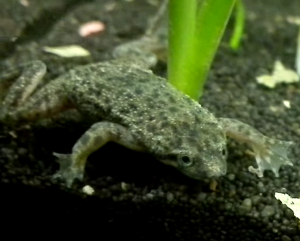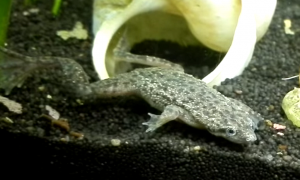The Dwarf African Frog (Hymenochirus curtipes) is a true aquatic species that many tropical fish keeping enthusiasts find a delightful addition to community aquariums. They are native to the Congo region of Africa where they are found along the bottoms of shallow rivers, creeks, and ponds where they scavenge around the mud and leaf litter for organic detritus, or any living, dying, or dead animal.
Dwarf African Frogs are a social, active, slow moving, docile species that are easy to keep in a peaceful community tank setting with others of their own kind, or smaller species of fish. They become easy prey to larger aquarium fish.
Although Dwarf African Frogs are an aquatic species, they do have lungs and must rise to the surface occasionally to breathe. They are toothless, tongueless, completely aquatic, and will die and dry out if kept out of water for periods longer than 20 minutes. When eating, they use their sensitive fingers and claws on their webbed feet to tear apart and suck food into their mouths. Dwarf African Frogs have no ears. Like fish, they have lateral lines that run down the length of their bodies that sense vibration and water movement. As their name suggests, they are a very small diminutive species that can vary in color from almost black, to olive green, to brown with black spots, to albino.
Juvenile Dwarf African Frogs are frequently confused and sold as African Clawed Frogs (Xenopus laevis) which grow much larger and are much more aggressive towards their tank mates.
They can be differentiated by the following characteristics:
- Unlike African Clawed frogs that have flat, curved snouts; the Dwarf African frog has a pointed snout.
- Dwarf African Frogs have four webbed feet, unlike the feet of African Clawed frogs which are only webbed on their hindquarters, their front feet are not webbed and have digits like salamanders and amphibious frogs.
- African clawed frogs have their eyes situated on the top of their heads, while the eyes of Dwarf African Frogs are positioned on the sides of their head.
The Hymenochirus genus contains two species; the Dwarf African Frog (Hymenochirus curtipes) and the Congo Dwarf Clawed Frog (Hymenochirus boettgeri) and possibly a subspecies that all look similar and share some common characteristics. The major difference between the two species is that H. curtipes has a much “wartier” textured skin.
Dwarf African Frogs are easier to care for when housed in a species only aquarium with 5 or 6 of their own kind. They are active but slow moving even when feeding. This can potentially cause starvation problems in a community environment when faster moving fish eat the food intended for the frogs.
Dwarf African Frogs are best kept in a densely planted aquarium of at least 10 gallon capacity, with a soft sand or fine gravel substrate, some driftwood or bogwood, some rockwork for them to hide among, and a layer of fine Indian Almond Leaves
if setting up a biotope tank. Because they are a largely nocturnal species, subdued lighting or floating plants
, a moderate filtration system with very little current, and a tightly fitting tank cover to prevent escapes, is recommended.
Although these frogs are amphibians, they are not great swimmers and they do not do well in tanks with strong currents or in deep tanks that make their journey to the surface for breathing perilous.
Breeding Dwarf African frogs is relatively easy once you have identified a pair.
- Males have small whitish or pink colored glad behind each armpit that looks like a small pimple, are skinnier and slightly smaller than the females, and make a quiet buzzing or humming sound when trying to attract females for mating.
- Females have a small bump between their legs called the cloaca where the eggs and their wast pass. They are usually larger than the males and have a plumper body shape. Both sexes are sexually mature at approximately 9 months.
When ready to mate, the male will start calling for a female and perform a little courtship dance. When a willing female becomes available, he will grasp her from behind, and the pair will rapidly perform a series of somersault to the surface. While the male remains attached to the female, she will broadcast her eggs on the surface in short spurts over a period of 1/2 to 3 or 4 hours until spawning is complete.
Dwarf African Frogs are carnivores that require meaty foods like live, frozen, or freeze dried bloodworms, tubifex
, chopped earthworms, and brine shrimp. They will also eat fish smaller than themselves.
Dwarf African Frogs are commonly available for purchase at reasonable prices when they are 1/2″ to 1-1/4″ in size.
Minimum Tank Size: 10 gallons
Care Level: Easy
Temperament: Docile
Aquarium Hardiness: Hardy
Water Conditions: 72-82° F, KH 5-8, pH 6.8-7.8
Max Size: 2½”
Color Form: Brown, Green, Tan
Diet: Omnivore
Compatibility: Community tanks
Origin: Congo, Africa
Family: Pipidae
Life Span: 5-20 years
Aquarist Experience Level: Beginner




